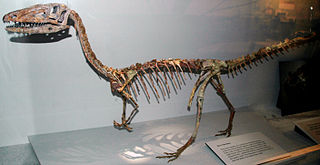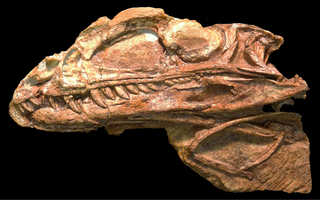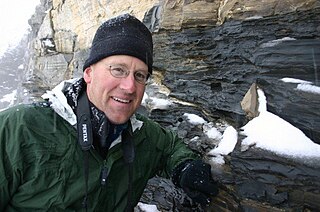
Dilophosaurus is a genus of theropod dinosaurs that lived in what is now North America during the Early Jurassic, about 186 million years ago. Three skeletons were discovered in northern Arizona in 1940, and the two best preserved were collected in 1942. The most complete specimen became the holotype of a new species in the genus Megalosaurus, named M. wetherilli by Samuel P. Welles in 1954. Welles found a larger skeleton belonging to the same species in 1964. Realizing it bore crests on its skull, he assigned the species to the new genus Dilophosaurus in 1970, as Dilophosaurus wetherilli. The genus name means "two-crested lizard", and the species name honors John Wetherill, a Navajo councilor. Further specimens have since been found, including an infant. Fossil footprints have also been attributed to the animal, including resting traces. Another species, Dilophosaurus sinensis from China, was named in 1993, but was later found to belong to the genus Sinosaurus.

Coelophysis is a genus of coelophysid theropod dinosaur that lived approximately 215 to 208.5 million years ago during the Late Triassic period from the middle to late Norian age in what is now the southwestern United States. Megapnosaurus was once considered to be a species within this genus, but this interpretation has been challenged since 2017 and the genus Megapnosaurus is now considered valid.

Coelophysoidea is an extinct clade of theropod dinosaurs common during the Late Triassic and Early Jurassic periods. They were widespread geographically, probably living on all continents. Coelophysoids were all slender, carnivorous forms with a superficial similarity to the coelurosaurs, with which they were formerly classified, and some species had delicate cranial crests. Sizes range from about 1 to 6 m in length. It is unknown what kind of external covering coelophysoids had, and various artists have portrayed them as either scaly or feathered. Some species may have lived in packs, as inferred from sites where numerous individuals have been found together.

Gojirasaurus is a genus of "coelophysoid" theropod dinosaur from the Late Triassic of New Mexico. It is named after the giant monster movie character Godzilla, and contains a single species, Gojirasaurus quayi.
Podokesaurus is a genus of coelophysoid dinosaur that lived in what is now the eastern United States during the Early Jurassic Period. The first fossil was discovered by the geologist Mignon Talbot near Mount Holyoke, Massachusetts, in 1910. The specimen was fragmentary, preserving much of the body, limbs, and tail. In 1911, Talbot described and named the new genus and species Podokesaurus holyokensis based on it. The full name can be translated as "swift-footed lizard of Holyoke". This discovery made Talbot the first woman to find and describe a non-bird dinosaur. The holotype fossil was recognized as significant and was studied by other researchers, but was lost when the building it was kept in burned down in 1917; no unequivocal Podokesaurus specimens have since been discovered. It was made state dinosaur of Massachusetts in 2022.

Revueltosaurus is an extinct genus of suchian pseudosuchian from Late Triassic deposits of New Mexico, Arizona and North Carolina, United States. Many specimens, mostly teeth, have been assigned to Revueltosaurus over the years. Currently, three species are included in this genus, all of which were originally thought to represent monospecific genera of basal ornithischian dinosaurs. Revueltosaurus was about 1 meter long.

Camposaurus is a coelophysid dinosaur genus from the Norian stage of the Late Triassic period of North America. The pertinent fossil remains date back to the early to middle Norian stage, and is widely regarded as the oldest known neotheropod.

Crosbysaurus is a genus of extinct archosauromorph that lived in the Late Triassic of Arizona, New Mexico, North Carolina, Texas, and Utah. It is known from the Chinle Formation and Dockum Group rock units from the southwestern United States. The type species is C. harrisae, and the only known material includes teeth. 11 specimens are known, each including a single tooth.

The Chinle Formation is an Upper Triassic continental geological formation of fluvial, lacustrine, and palustrine to eolian deposits spread across the U.S. states of Nevada, Utah, northern Arizona, western New Mexico, and western Colorado. In New Mexico, it is often raised to the status of a geological group, the Chinle Group. Some authors have controversially considered the Chinle to be synonymous to the Dockum Group of eastern Colorado and New Mexico, western Texas, the Oklahoma panhandle, and southwestern Kansas. The Chinle Formation is part of the Colorado Plateau, Basin and Range, and the southern section of the Interior Plains. A probable separate depositional basin within the Chinle is found in northwestern Colorado and northeastern Utah. The southern portion of the Chinle reaches a maximum thickness of a little over 520 meters (1,710 ft). Typically, the Chinle rests unconformably on the Moenkopi Formation.

The Glen Canyon Group is a geologic group of formations that is spread across the U.S. states of Nevada, Utah, northern Arizona, north west New Mexico and western Colorado. It is called the Glen Canyon Sandstone in the Green River Basin of Colorado and Utah.

The Moenave Formation is a Mesozoic geologic formation, in the Glen Canyon Group. It is found in Utah and Arizona.

Tawa is a genus of possible basal theropod dinosaurs from the Late Triassic period. The fossil remains of Tawa hallae, the type and only species were found in the Hayden Quarry of Ghost Ranch, New Mexico, US. Its discovery alongside the relatives of Coelophysis and Herrerasaurus supports the hypothesis that the earliest dinosaurs arose in Gondwana during the early Late Triassic period in what is now South America, and radiated from there around the globe. The specific name honours Ruth Hall, founder of the Ghost Ranch Museum of Paleontology.
The Chinle Formation is an extensive geological unit in the southwestern United States, preserving a very diverse fauna of Late Triassic animals and plants. This is a list of fossilized organisms recovered from the formation.
Kayentavenator is a genus of small carnivorous tetanuran dinosaur that lived during the Early Jurassic Period; fossils were recovered from the Kayenta Formation of northeastern Arizona and were described in 2010.

Sarahsaurus is a genus of basal sauropodomorph dinosaur which lived during the Early Jurassic period in what is now northeastern Arizona, United States.

Daemonosaurus is an extinct genus of possible theropod dinosaur from the Late Triassic of New Mexico. The only known fossil is a skull and neck fragments from deposits of the latest Triassic Chinle Formation at Ghost Ranch. Daemonosaurus was an unusual dinosaur with a short skull and large, fang-like teeth. It lived alongside early neotheropods such as Coelophysis, which would have been among the most common dinosaurs by the end of the Triassic. However, Daemonosaurus retains several plesiomorphic ("primitive") traits of the snout, and it likely lies outside the clade Neotheropoda. It may be considered a late-surviving basal theropod or non-theropod basal saurischian, possibly allied to other early predatory dinosaurs such as herrerasaurids or Tawa.
The Bull Canyon Formation is a geological formation of Late Triassic (Norian) age in eastern New Mexico and the Texas Panhandle. It is one of several formations encompassed by the Dockum Group.

Coelophysis? kayentakatae is an extinct species of neotheropod dinosaur that lived approximately 200–196 million years ago during the early part of the Jurassic Period in what is now the southwestern United States. It was originally named Syntarsus kayentakatae, but the genus Syntarsus was found to be preoccupied by a Colydiine beetle, so it was moved to the genus Megapnosaurus, and then to Coelophysis. A recent reassessment suggests that this species may require a new genus name.

The Rock Point Formation is a geologic formation in New Mexico, Arizona, and Utah. It preserves fossils dating back to the late Triassic.

John Russell Foster is an American paleontologist. Foster has worked with dinosaur remains from the Late Jurassic of the Colorado Plateau and Rocky Mountains, Foster is also working on Cambrian age trilobite faunas in the southwest region of the American west. He named the crocodyliform trace fossil Hatcherichnus sanjuanensis in 1997 and identified the first known occurrence of the theropod trace fossil Hispanosauropus in North America in 2015.















